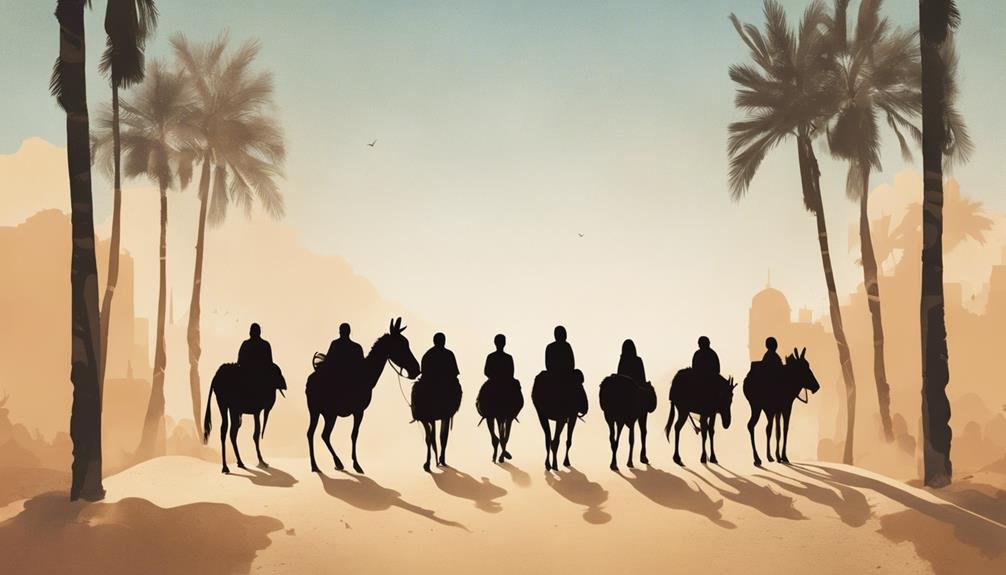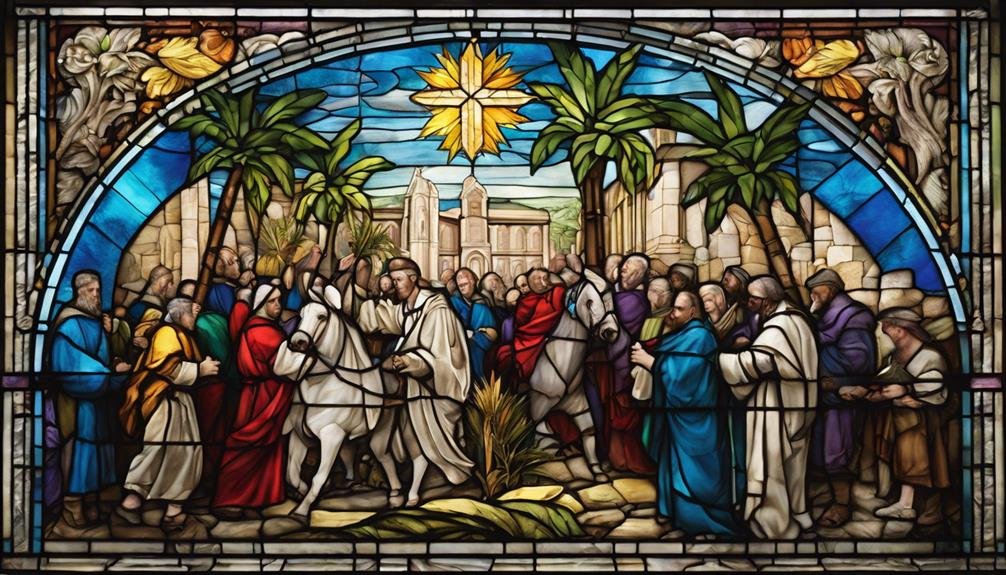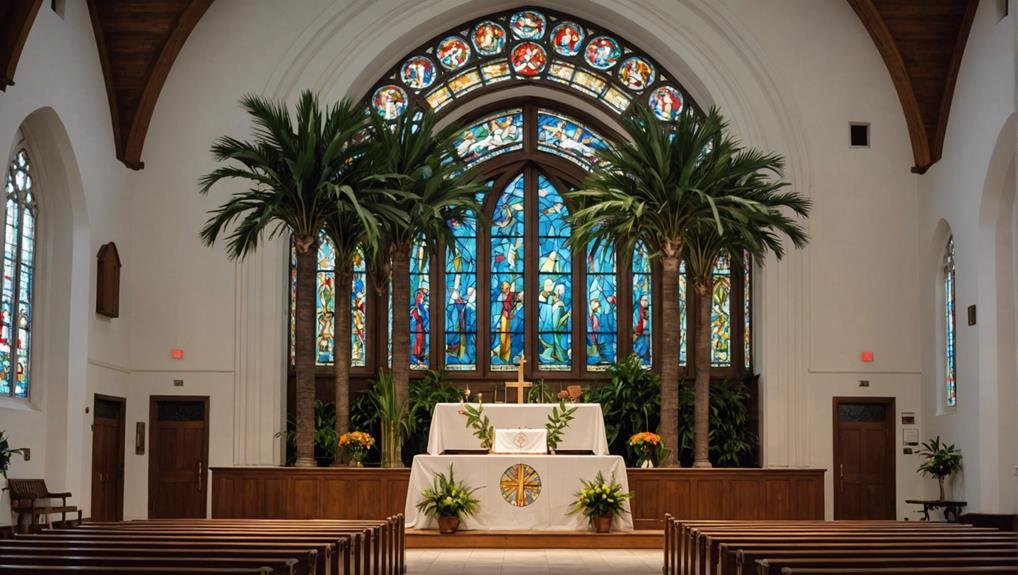As you explore the profound symbolism of palms in Christian worship, you’ll uncover layers of meaning that have resonated through centuries.
The palm branch isn’t just a decoration; it’s a potent emblem of triumph and peace, celebrated from the ancient triumphal entry to today’s Palm Sunday observances. Each aspect of its usage, from liturgical practices to artistic representations, weaves a rich tapestry of theological significance.
What might seem like a simple green leaf holds prophecy, victory, and divine kingship stories. Aren’t you curious how these symbols shape believers’ faith and worship experiences worldwide?
Key Takeaways
- Palms symbolize victory over sin, representing Jesus as the triumphant divine king.
- Waving palms on Palm Sunday acknowledges Jesus’s roles as Messiah and King.
- In art, palms frame depictions of Jesus’s entry into Jerusalem, emphasizing his kingship.
- Palms woven into crosses during processions highlight the victory and sacrifice of Jesus.
- Palms in modern worship involve congregants actively, reviving reverence similar to Jesus’s first followers.
Historical Roots of Palm Symbols
Before their adoption into Christianity, palms were already celebrated as symbols of victory in ancient cultures. When Jesus entered Jerusalem, the crowds’ use of palm branches had deep-rooted historical significance.
You can imagine the scene: as He approached, people waved palms, laying them down before Him as a carpet of honor. This act was rich with symbolic meaning, echoing the victories celebrated by their ancestors.
This tradition found new depth in Christian symbolism as early followers adopted the palm as their emblem of triumph in earthly battles and spiritual warfare. The palm came to represent victory over sin and death, a particularly potent symbol for martyrs who’d won their spiritual battles through ultimate sacrifice.
Early Christian art often depicts martyrs with palms. These images adorned the catacomb tombs, hinting at the deceased’s victory over death.
Over time, this usage evolved, and the palm appeared in various forms on Christian monuments, each adaptation echoing the longstanding victory narrative but deepening it to encompass the eternal triumphs of faith.
Palm Branches and Prophecy
Palm branches, during Jesus’s triumphal entry into Jerusalem, vividly symbolize the fulfillment of ancient prophecies. As you explore this historical moment, you’ll notice that palm branches aren’t just casual decor elements but are deeply prophetic.
The Old Covenant foretold them as signs that would mark the Messiah’s arrival. The crowd waving palm branches as Jesus entered the city on a donkey wasn’t a spontaneous gesture but a fulfillment of a specific prophecy from the book of Zechariah.
This prophecy outlined that the true King of the Jews would be welcomed in such a manner, signifying both royal status and divine approval. The palms weren’t merely celebratory but acknowledgments of Jesus as the promised Messiah.
By waving these branches, the people of Jerusalem placed Jesus directly into the heart of God’s prophetic timeline, recognizing Him as the awaited leader who’d bring peace and salvation.
You understand why palm branches are significant in Christian worship today. They aren’t just reminders of a historical event but are enduring symbols of prophecy fulfilled, linking past anticipations with present faith and future hope.
The Triumphal Entry Explained

As Jesus approached Jerusalem on Palm Sunday, the crowd waving palm branches and laying cloaks on the road symbolized their recognition of Him as the promised Messiah and King.
This pivotal moment, known as the Triumphal Entry, wasn’t just a spontaneous act of celebration; it was a profound acknowledgment of Jesus’s royal and messianic identity, fulfilling ancient prophecies.
By choosing palm branches and cloaks as symbols, the people declared Jesus their sovereign, akin to a ceremonial enthronement.
Palms were traditionally associated with victory and triumph; laying one’s cloak on the ground was a sign of utmost respect and submission to authority. As you reflect on this scene, imagine the powerful emotions of hope and reverence that must have filled the air.
This event wasn’t merely a prelude to the Holy Week but a declaration of Jesus’s dual role as High Priest and King, underscoring His journey toward ultimate victory over sin through His crucifixion. The Triumphal Entry, hence, stands as a significant affirmation of His kingship and the deep spiritual anticipation of His sacrificial role.
Palms in Liturgical Celebrations
Reflecting on the Triumphal Entry, consider how using palms during liturgical celebrations like Palm Sunday continues to honor Jesus’s royal and messianic identity.
When you grasp a palm branch on this day, you’re partaking in a centuries-old tradition that marks Jesus’s majestic journey into Jerusalem. It’s not just a ritual; it’s a profound worship act connecting you with the biblical narrative of Jesus as the King of Kings and the promised Messiah.
As you wave your palm branch, remember that each motion symbolizes the honor and recognition the multitudes gave Jesus during His entry. The palms aren’t mere decorations but powerful symbols of your acknowledgment of His royal and priestly roles.
This act ties directly to the scenes described in John 12:12 and Matthew 21:7-9, where the crowd welcomed Jesus with palms and clothing strewn along His path.
This tradition underscores Jesus’s identity as the High Priest and King, emphasizing the profound significance of His ministry.
Every Palm Sunday, the simple act of waving palm branches revives the reverence and deep respect that the first followers showed, making the historical moment ever-present in your worship experience.
Symbolism of Victory and Peace

In Christian worship, palm branches aren’t just decorative but deeply symbolic, representing victory over sin and peace. These branches have a profound role, especially when considering their use during significant events in Jesus’s life.
When Jesus entered Jerusalem, the crowd spread palm branches and cloaks on the road. This wasn’t just a spontaneous act of celebration; it was a deeply symbolic gesture acknowledging Him as the promised Messiah, the King of Kings, and the High Priest.
Hence, the palm branches aren’t merely foliage but are imbued with rich symbolism. They signify the triumph of the divine king over sin and the establishment of peace through His ministry.
From when Jesus began His ministry at the age of 30, the palms were a foretelling of victory and peace that He’d bring.
Palms and Martyrdom
While palms symbolize victory and peace, they also represent the triumph over spiritual foes in the context of martyrdom. These symbols might be particularly poignant in the ancient catacomb tombs, where the early Christians marked the resting places of martyrs.
Here’s how the palm has evolved in its significance:
- Symbol of Martyrdom: Initially, palms on tombs were exclusively seen as identifiers of Christian martyrs, signifying their victory over death through faith.
- Pagan Adoption: Later discoveries showed palms on pagan tombs as well, suggesting a broader cultural symbol of victory beyond Christian martyrdom.
- Enduring Symbol: Despite these variations, the core idea of the palm as a symbol of spiritual victory remains influential in Christian art and worship.
As you further explore the history and art of Christian worship, you’ll see how the palm transcends its initial associations, embodying a legacy of faith and resilience.
Theological Implications of Palms

In Christian worship, palms symbolize victory and peace and represent Jesus as the King of Kings and High Priest. Palm branches are not just decorative in a church setting.
They carry deep theological significance, anchoring the narrative of Jesus’s triumphal entry into Jerusalem, which marked the beginning of his ministry at the age of 30. This event wasn’t just a historical moment but a prophetic fulfillment, showcasing Jesus as the promised Messiah.
The palms and cloaks laid on the road are potent symbols. They don’t just commemorate a past event; they actively declare Jesus’s dual role as both High Priest and King.
This dual role is central to understanding His mission and the nature of His kingdom, which differs from earthly dominions. His kingdom is about spiritual victory and eternal peace, vividly symbolized by the palm branches waved by the joyful crowd.
Thus, whenever you hold or see palm branches during worship, remember they remind you of Jesus’s victory over death and His ongoing reign. They invite you to reflect on His peace, which surpasses all understanding, and His eternal kingship in your life.
Cultural Variations in Palm Usage
How do different Christian communities worldwide incorporate palm branches into their worship practices? Palm branches transcend geographical boundaries, adapting to local customs and historical contexts to enhance the spiritual experience.
Each tradition brings a unique flavor to this common symbol, reflecting the rich tapestry of Christian worship. Here’s a look at how the incorporation of palm branches varies:
- In Latin America, palms might be decorated with flowers and ribbons, highlighting the festive nature of Palm Sunday celebrations.
- In Northern Europe, The colder climate means that branches from native trees sometimes replace actual palm branches, though they’re treated with the same reverence.
- In Africa, Palms are used in processions and placed around homes and churches as a sign of protection and blessing.
These cultural variations in palm usage show the adaptability of Christian practices and underscore the universal appeal and significance of palm branches in worship. Understanding these differences enriches your appreciation of how globally interconnected and yet locally unique Christian worship can be.
Palms in Art and Iconography

Exploring palms in Christian art and iconography reveals their deep symbolic importance as emblems of victory, triumph, and peace. You’ll see that artists have consistently used palm branches to signify more than just decorative elements.
When you investigate traditional Christian paintings or stained glass windows, palm branches often frame scenes of Jesus’s entry into Jerusalem, a pivotal moment captured in the Gospels.
In these artistic depictions, the palm branches and cloaks strewn across the road don’t just add to the aesthetic; they symbolize the recognition of Jesus as the promised Messiah.
This portrayal aligns with biblical references, such as John 12:12 and Matthew 21:7-9, where the crowds greet Jesus with palm branches, an act of honor and celebration of his kingship and divine mission.
The consistent use of palms in art highlights their importance in understanding Jesus’s identity and ministry. As you explore Christian iconography, you’ll appreciate how these artistic choices aren’t merely ornamental but are laden with rich theological significance.
Modern Practices and Palms
Did you know palm branches are still waved during modern Christian worship to commemorate Jesus’s triumphal entry into Jerusalem? This enduring symbol serves as a historical remembrance and enriches believers’ spiritual experience today.
Palm branches represent triumph, victory, and the recognition of Jesus as the King of Kings. Here are the key ways in which palm branches are utilized in contemporary Christian practices:
- Church Services: During Palm Sunday services, congregants often hold and wave palm branches as they sing hymns and participate in the liturgy, vividly reenacting Jesus’s entry.
- Processions: Many churches organize processions around their communities or within church grounds, with members carrying palm branches to proclaim their faith and remember Jesus’s journey publicly.
- Decorations: Palms are also used to decorate church altars and corridors, symbolizing a path of victory and sacrifice leading to Easter.
These practices ensure that the palm branch symbol inspires hope and salvation, honoring Jesus as the promised Messiah in a modern context.
Conclusion
As you’ve seen, palms are deeply embedded in Christian worship, symbolizing triumph, prophecy, and peace. Whether through historical traditions, liturgical celebrations, or modern practices, these symbols connect you directly to Jesus’s role as Messiah.
Embrace the rich symbolism in art and iconography to deepen your spiritual journey. Let each palm branch remind you of victory over sin and the promise of eternal peace, reaffirming your faith and the profound legacy of Christian worship.
Recommended Articles:
Exploring Palm Sunday Traditions Globally: A Tradition Guide
Do Jews Celebrate Easter? Insights into Jewish and Christian Holidays
Palm Sunday Celebrations in Spain: Vibrant Traditions And Cultural


